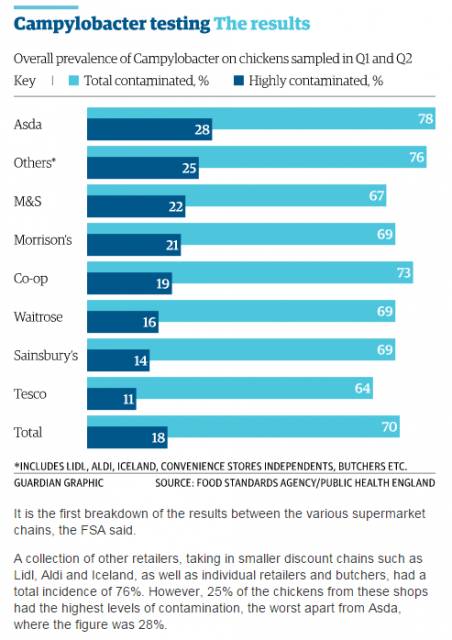The Food Standards Agency’s (FSA) released its “Name and Shame” Report this morning. The idea of testing retail chicken and publishing the results had been the focus of much discussion over the last few months. Some UK retailers were not very happy that the public would actually know how tainted the chicken really is.
If this had been the US equivalent, FSIS, we would be wondering why would the report be released on Thanksgiving Day. My guess is that in the UK Thanksgiving does not have the same meaning as it does over here.
Retailers had tried to block the study’s release.
 Well, back to the study; Campylobacter was found in 70 per cent of chicken tested up from 59 per cent of chickens in August. Almost a fifth of all chickens (18 per cent) tested positive for Campylobacter above the highest level of contamination, while six per cent of packaging tested positive – a rise of four per cent since August.
Well, back to the study; Campylobacter was found in 70 per cent of chicken tested up from 59 per cent of chickens in August. Almost a fifth of all chickens (18 per cent) tested positive for Campylobacter above the highest level of contamination, while six per cent of packaging tested positive – a rise of four per cent since August.
The FSA also revealed that Asda sold the highest percentage of chickens contaminated with the bug. Campylobacter was present in 78 per cent of chickens from the supermarket, with 28 per cent above the highest level of contamination.
Packaging testing showed 12 per cent was contaminated. Don’t forget the recent “chicken juice” report.
Almost three-quarters of chickens (73 per cent) sold by the Co-operative tested positive, followed by Morrisons, Sainsbury’s and Waitrose (69 per cent), Marks & Spencer (67 per cent) and Tesco (64 per cent).
Perhaps it is time to redo our 2011 testing of contamination levels in chicken purchased in Seattle. Here were some of the results:
The study showed that up to 80% of Seattle area raw chicken could be contaminated with some form of potentially harmful bacteria.
Testing done by IEH Laboratories in Lake Forest Park, Washington showed that 80 of 100 raw chickens purchased at various Seattle area grocery stores contained at least one potentially harmful pathogen.
The test was comprised of 18 brands of chicken purchased at 18 different Seattle area stores including chain grocery stores, Safeway (3 locations), Albertsons (2), QFC (4), Fred Meyer (2), Thriftway (1); warehouse clubs Costco (2) and Sam’s Club (1); natural foods stores Whole Foods (1) and PCC (1), and one small market, Ken’s Market (1).
In the study local and organic chicken did not prove to be safer than other samples. In terms of origination, 59 chicken samples originated from Washington, while 13 samples came from other states and 28 were of unknown origin. Regardless of place, chicken from every state tested was confirmed to contain potentially harmful bacteria. Of the 14 samples of organic chicken 12 contained harmful bacteria.
The study tested for five pathogens. While some findings were typical, other results were more surprising. Previous studies have found on average that 33 to 53% of chicken is contaminated with Campylobacter. In Seattle 65% of the chicken tested positive for Campylobacter. Salmonella was isolated in 19% of the chicken purchased at retail stores in the Seattle area, slightly higher than the expected average of 16%. Staphylococcus aureus was found in 42% of the chicken sampled; 10 of these samples were Methicillan-resistant, commonly known as MRSA. One sample cultured positive for Listeria monocytogenes and one sample cultured positive for E. coli O26, a bacteria often found in beef.